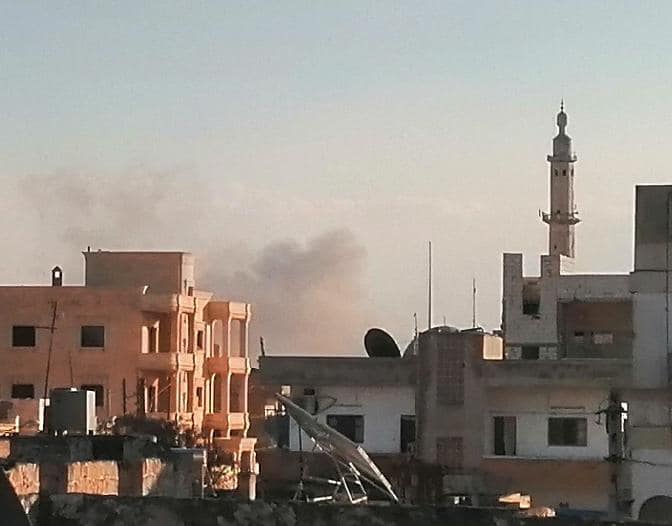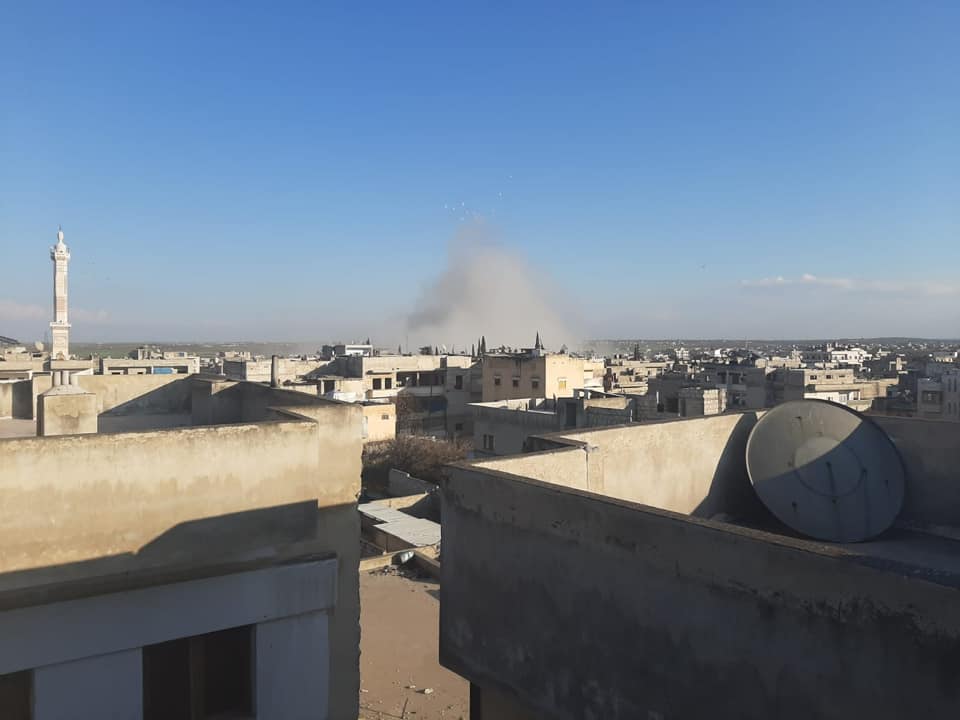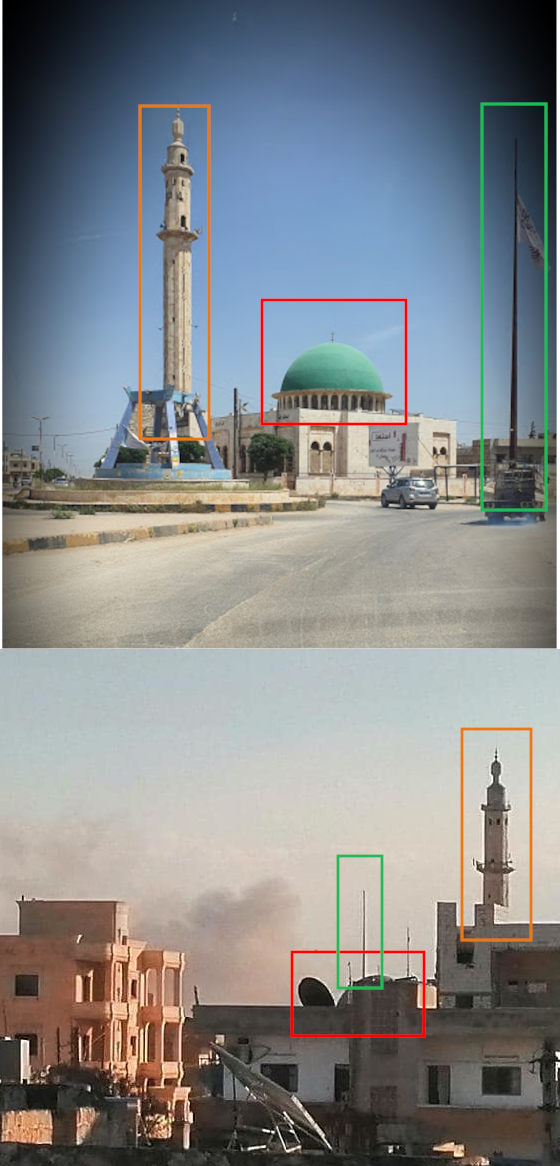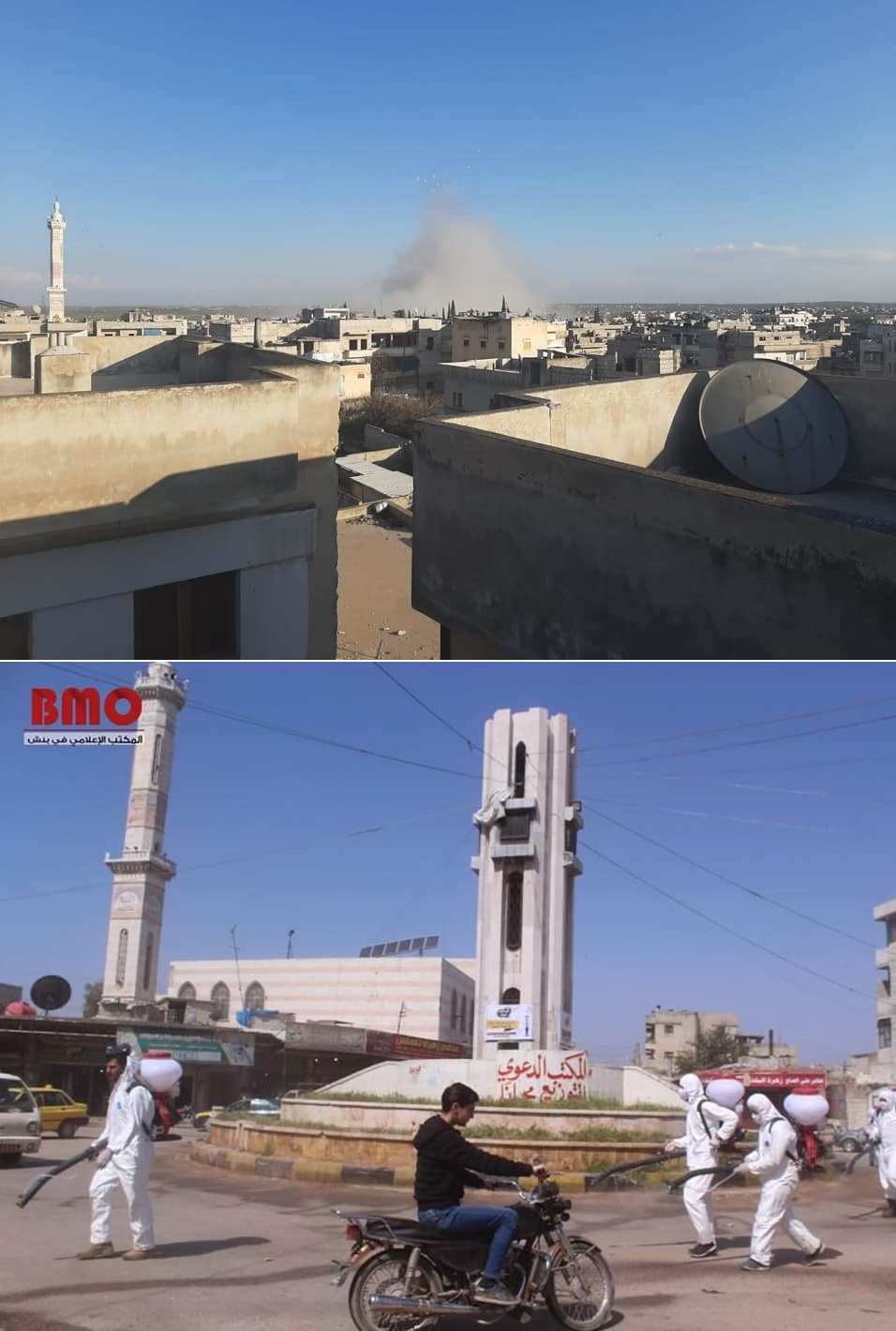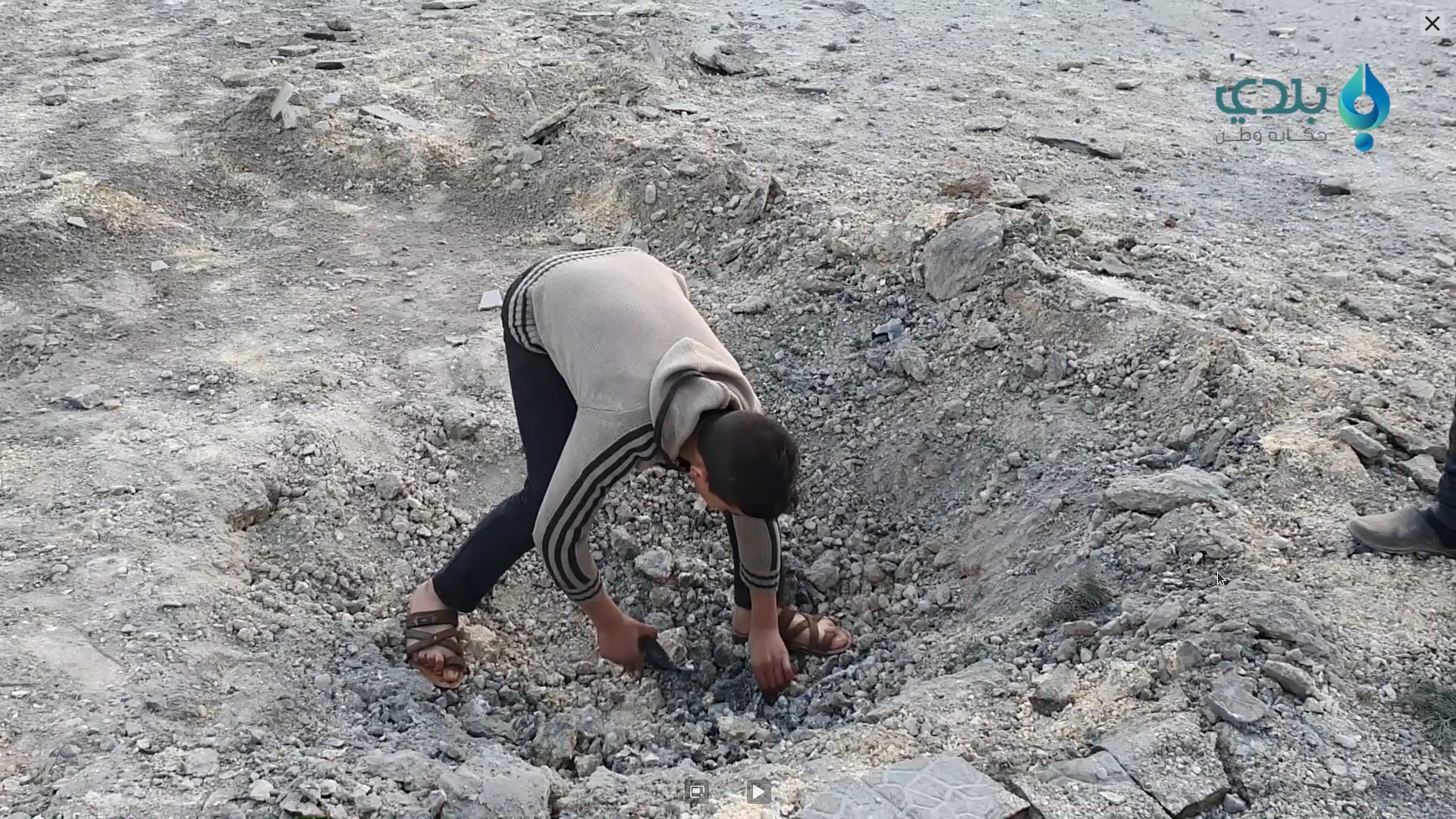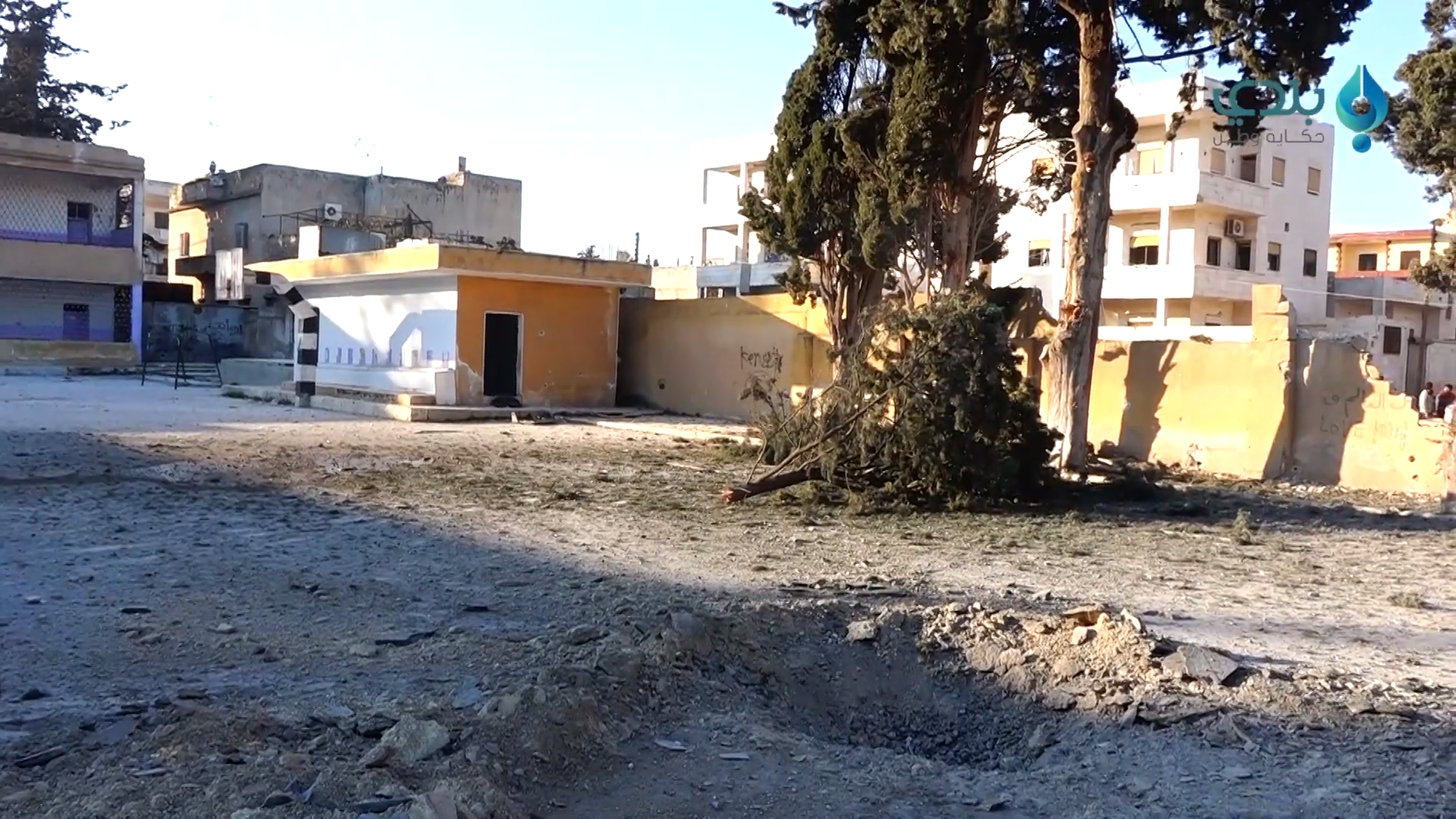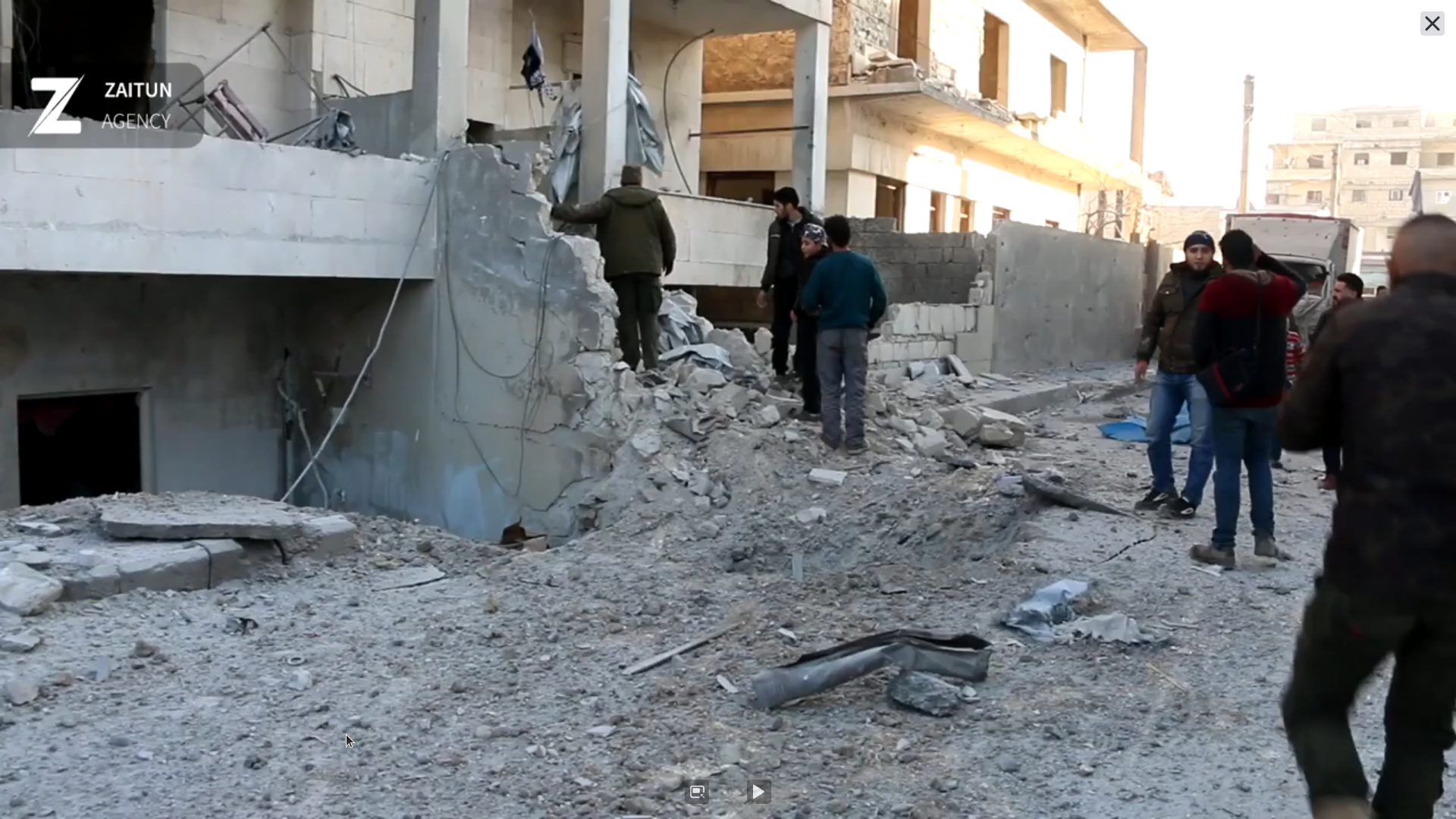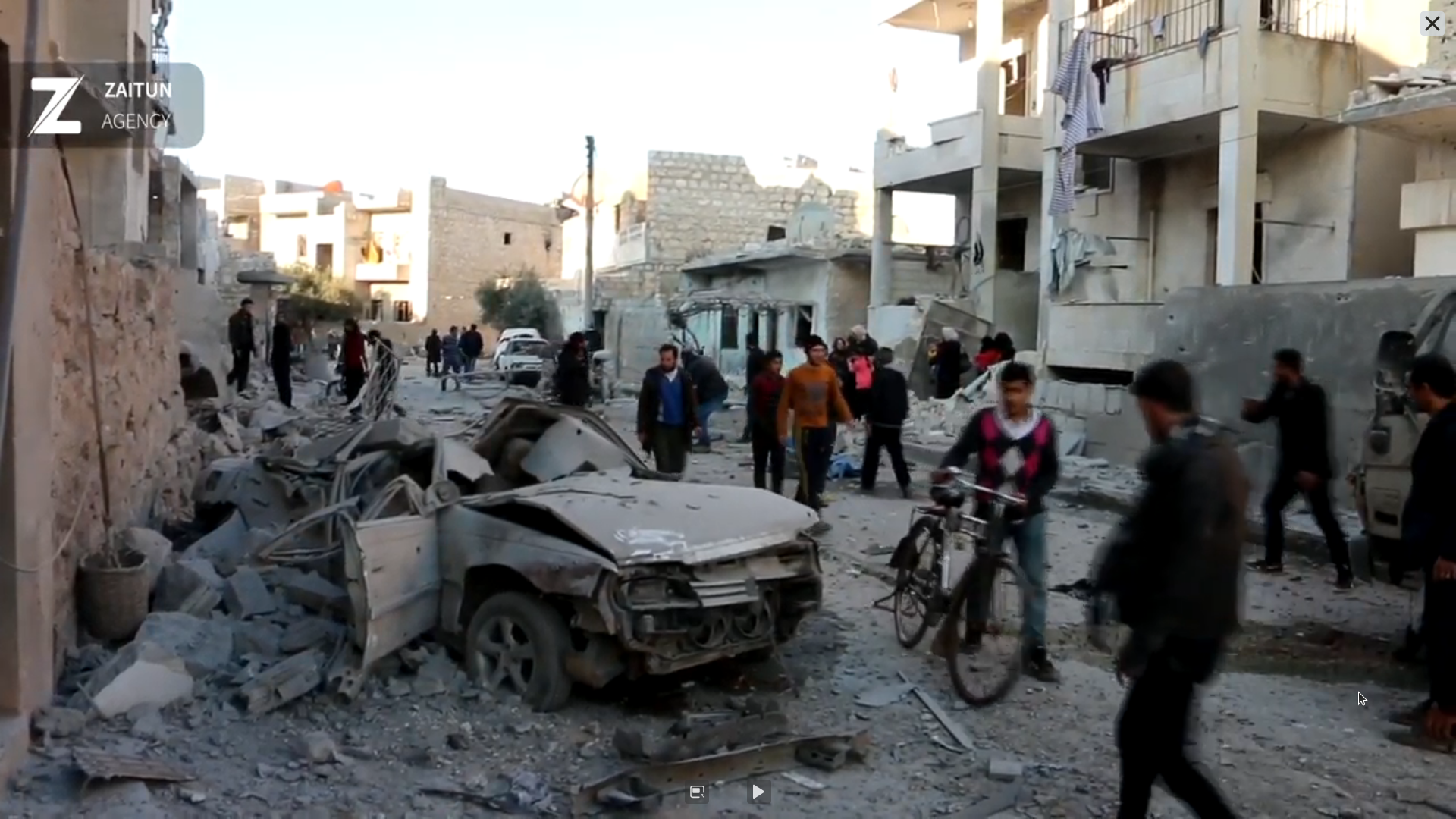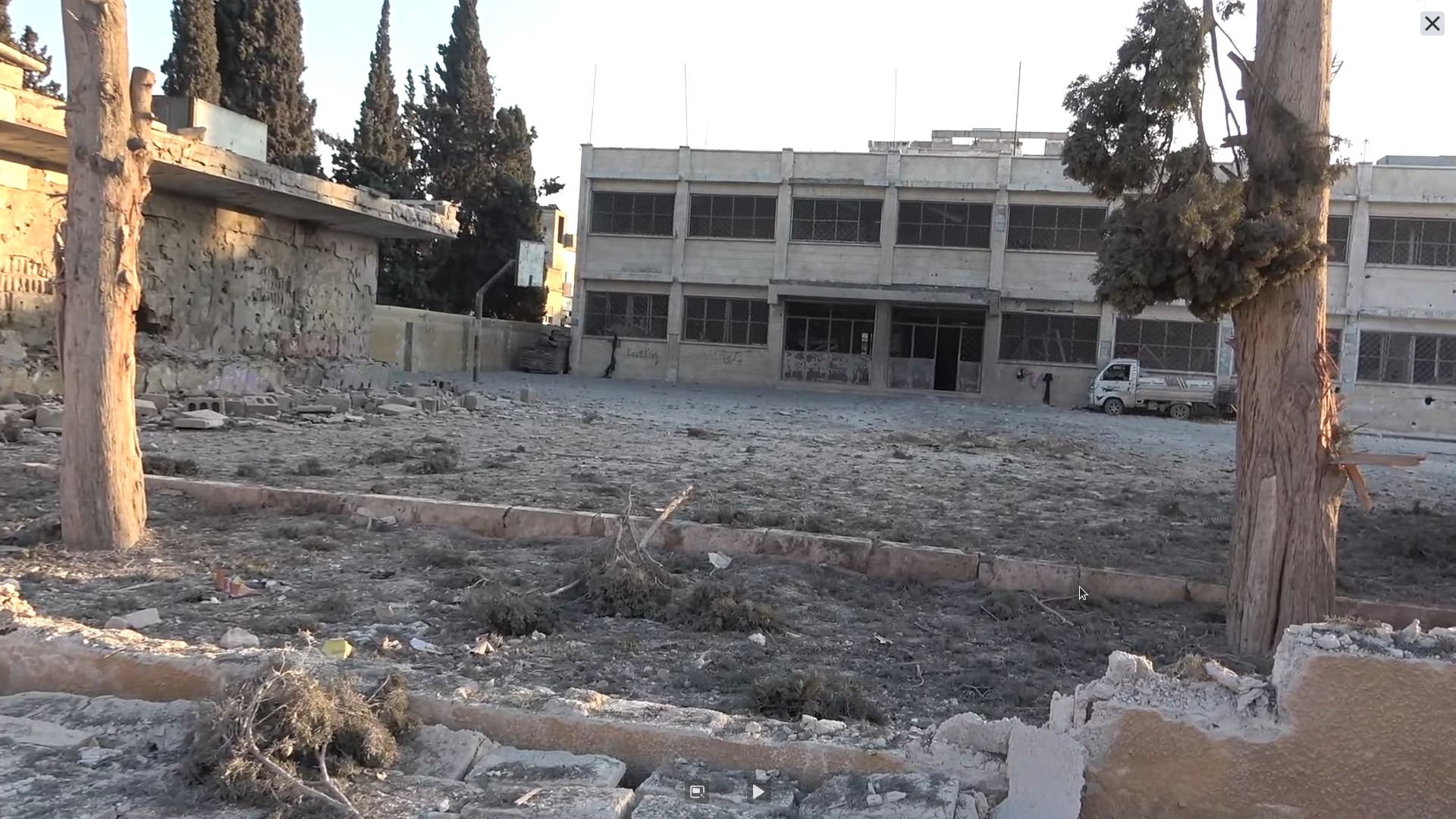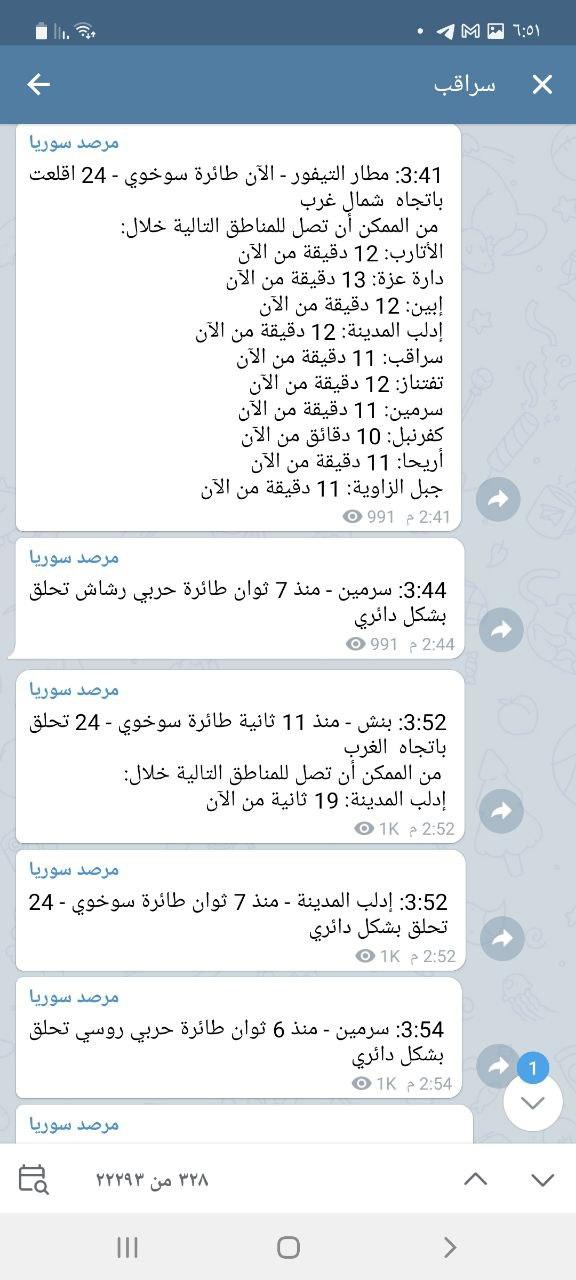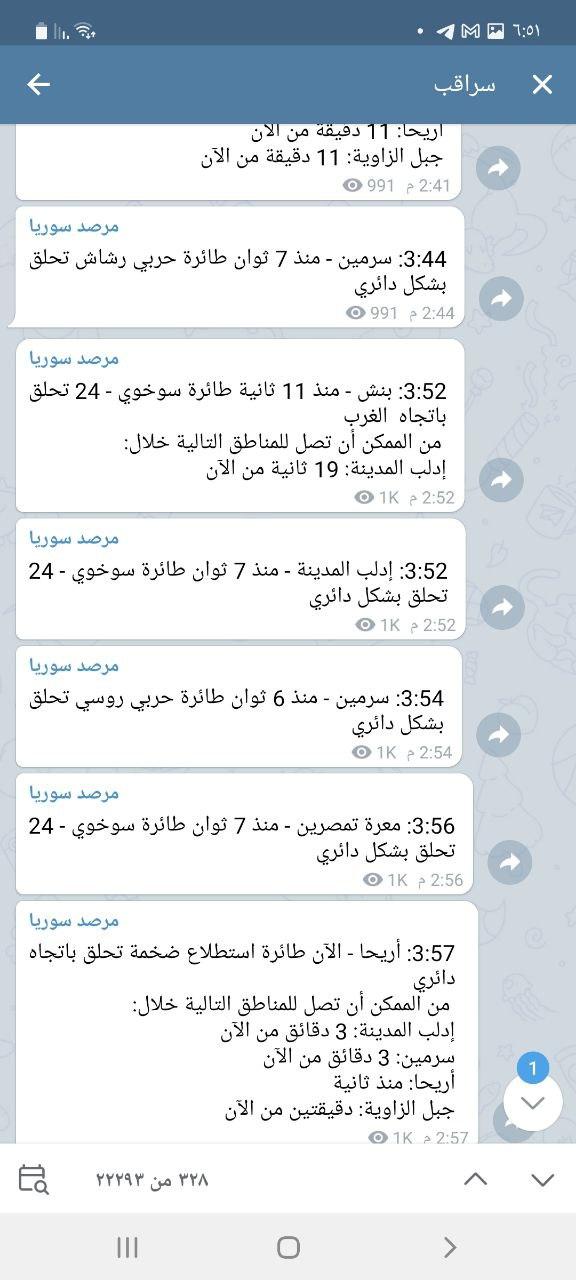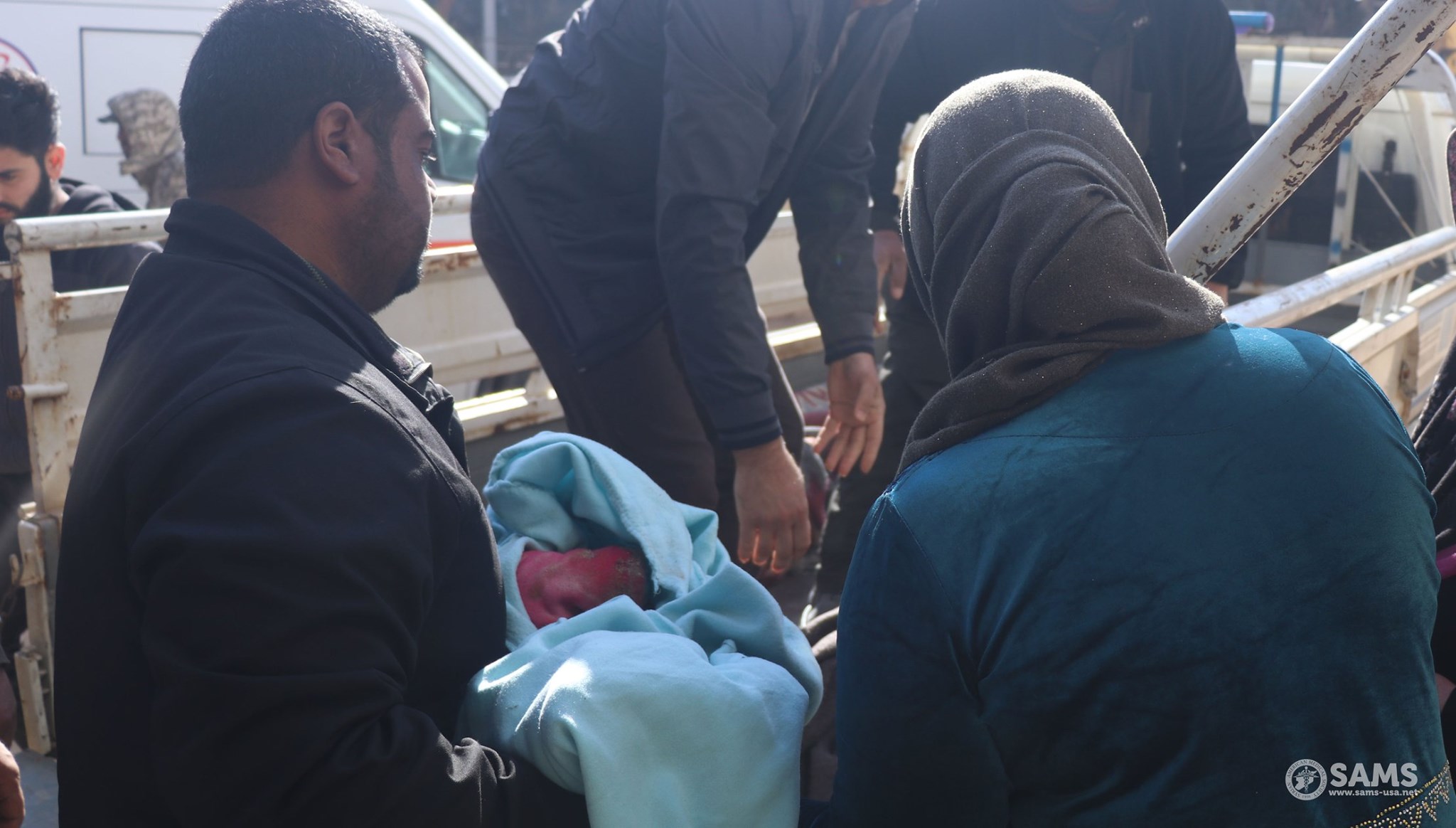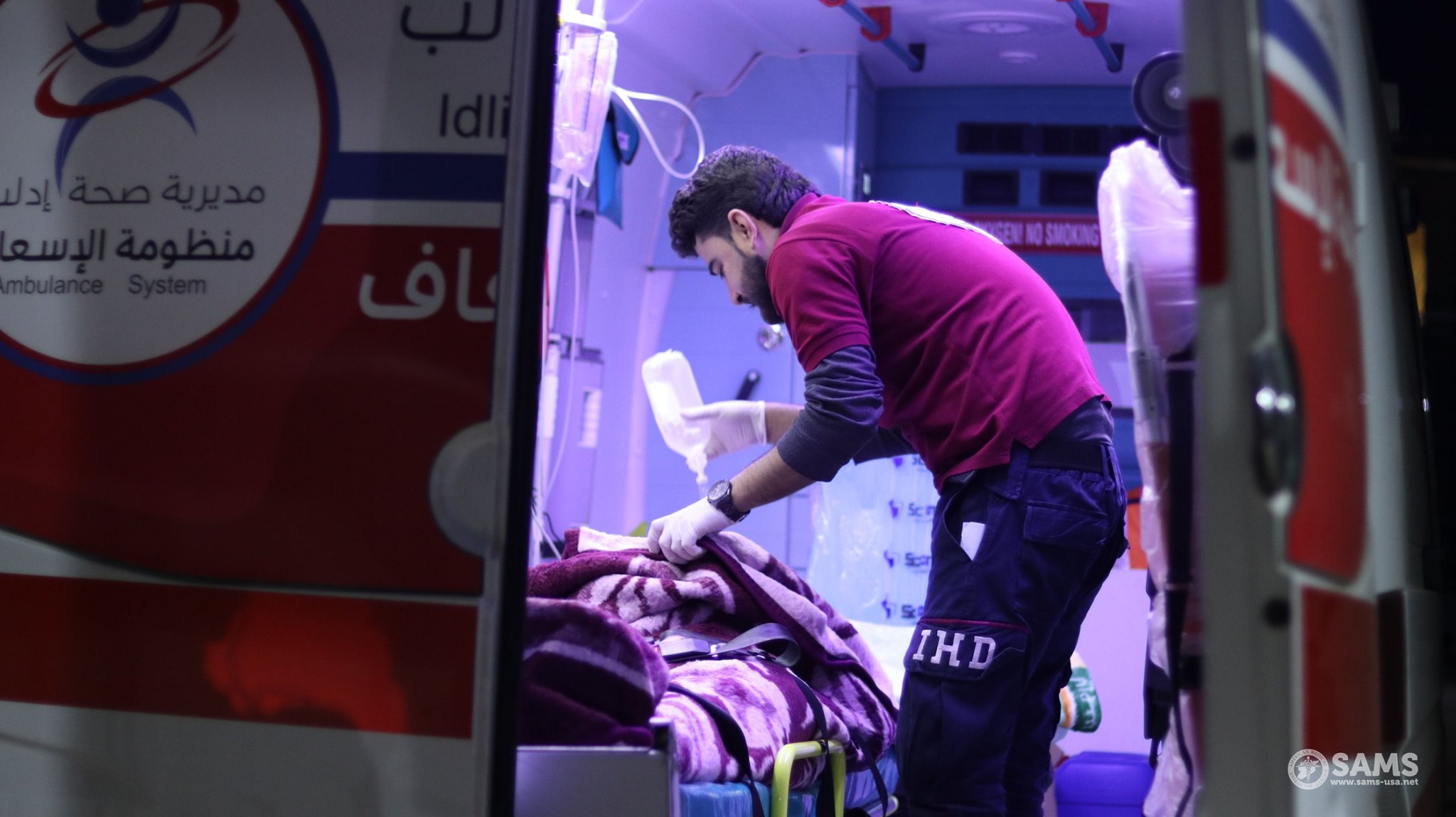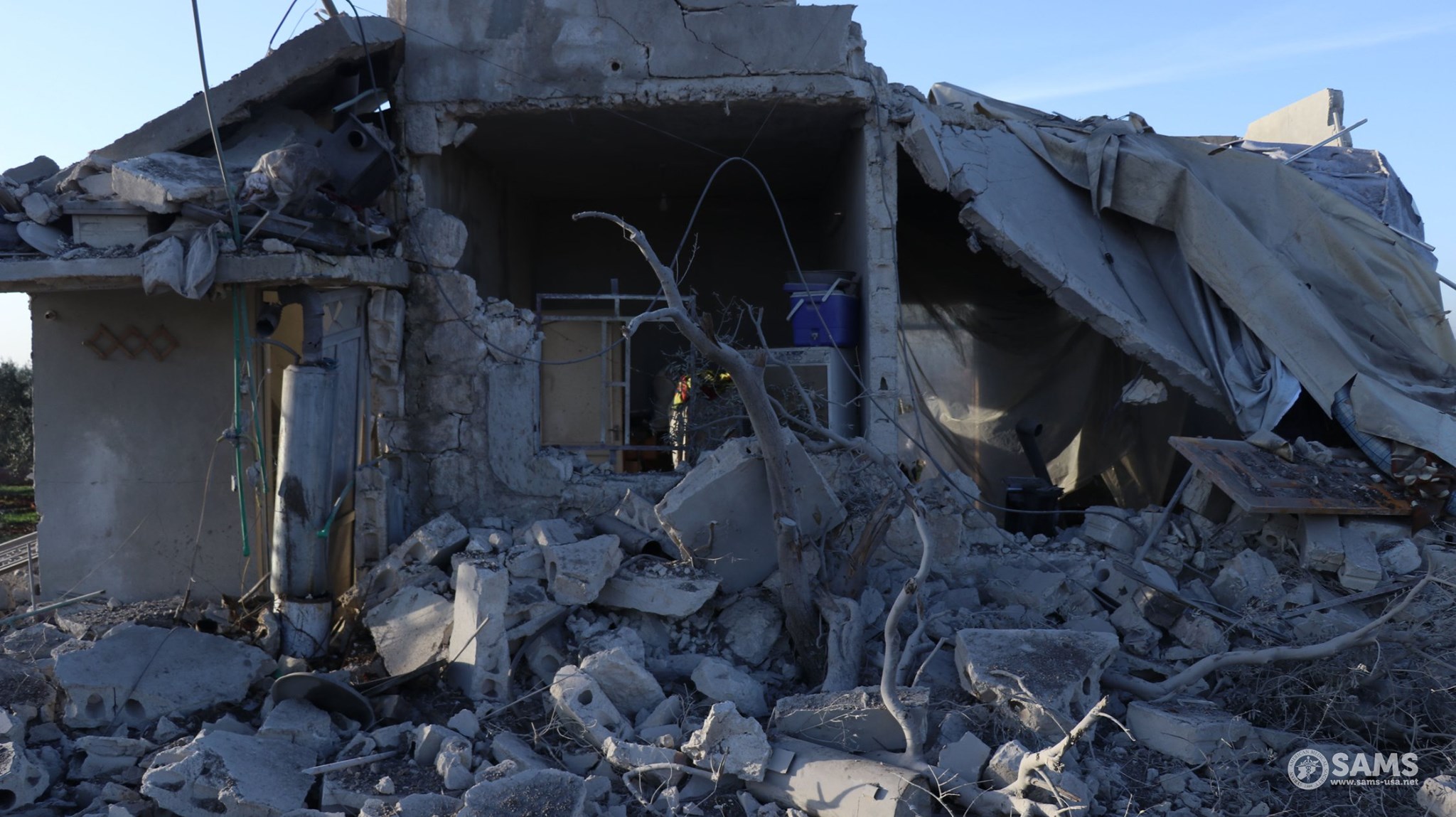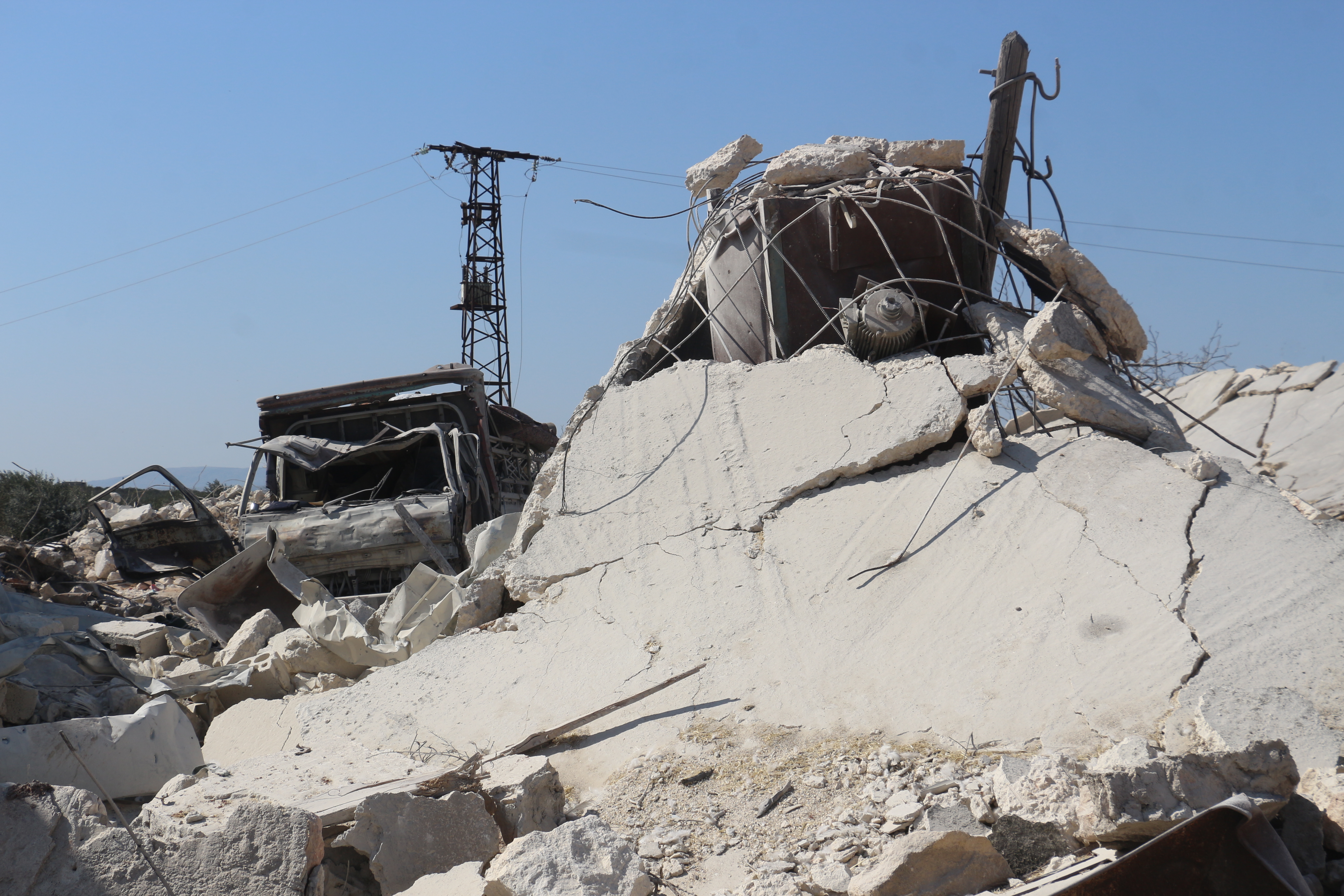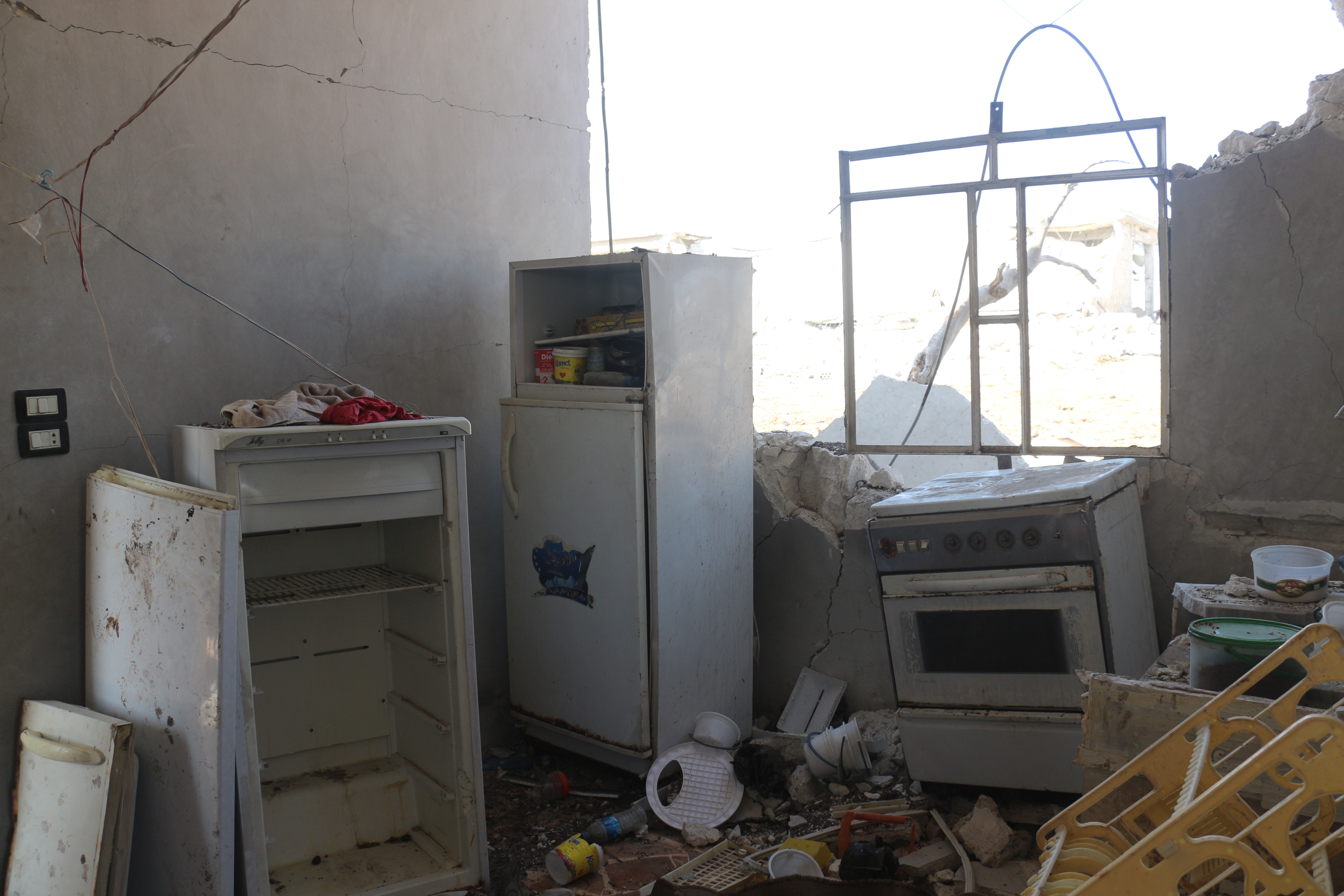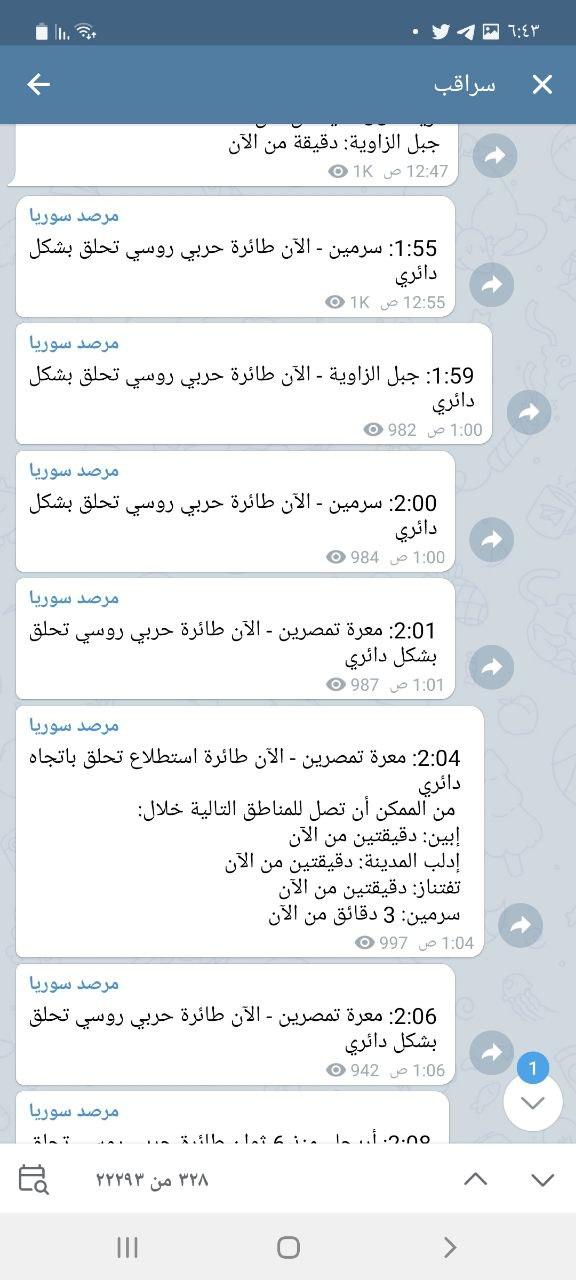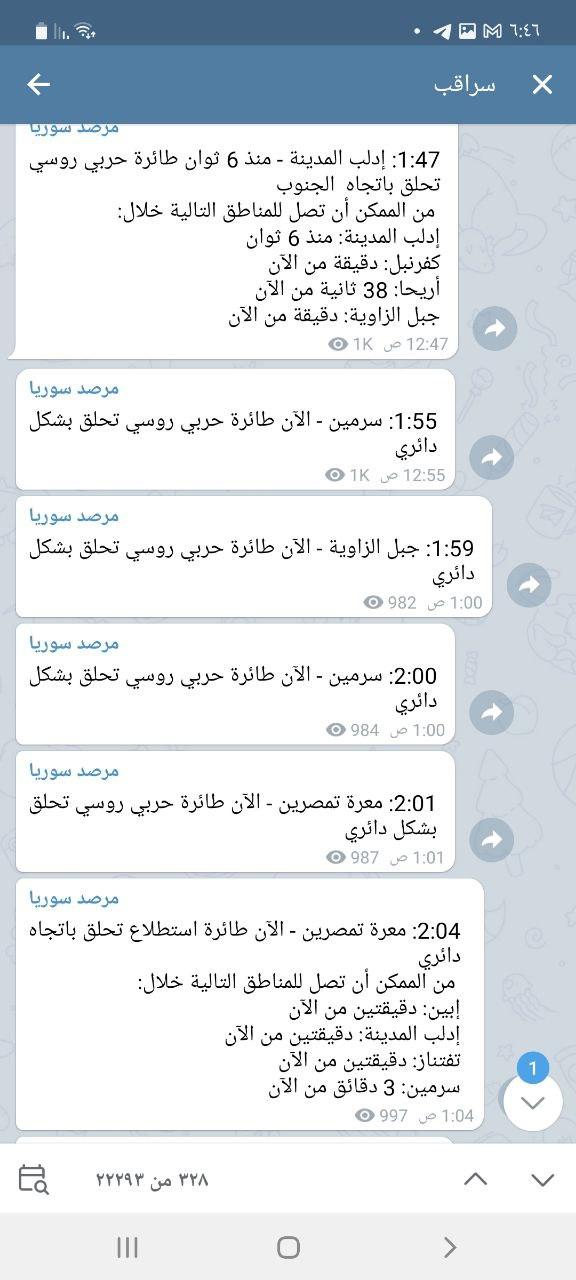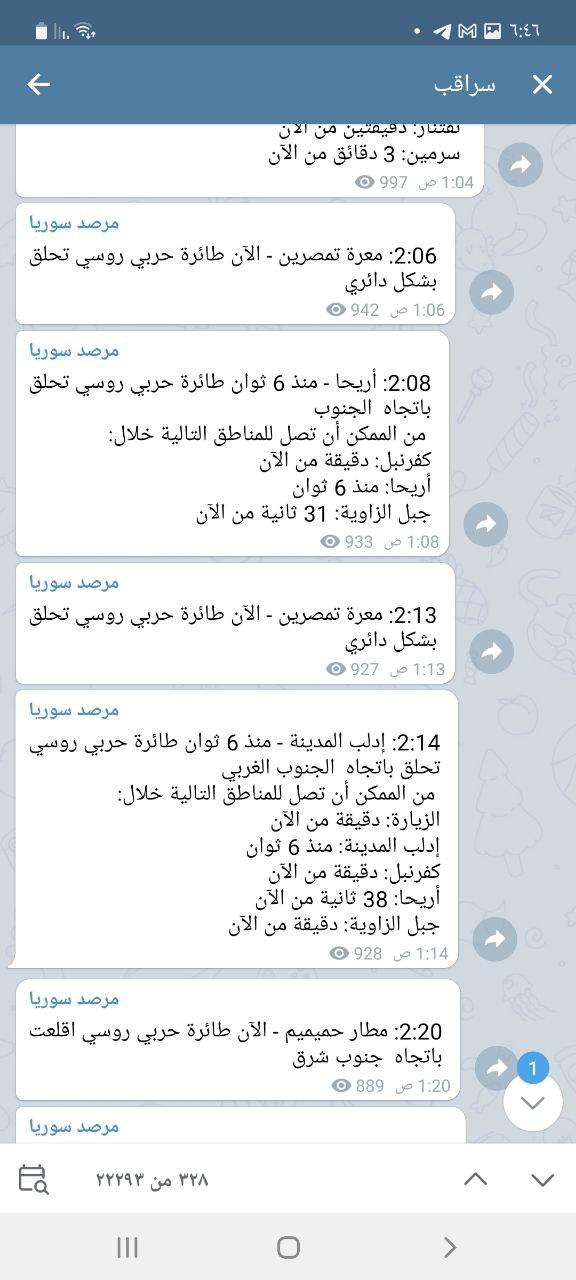Investigations
Airstrikes hit shelters for the displaced in Maaret Masreen
July 13, 2021An investigation into several airstrikes that hit a school and poultry farms sheltering displaced people in Maaret Masreen in the Idlib countryside
Print Article
- Introduction
- Methodology
- About Maaret Masreen
- The First Attack: Mounib Kamisha School
- What Happened (and When)?
- The Damage to the School and the Surrounding Areas
- Flight Data Analysis
- Summary
- The Second Attack: A Poultry Farm in Maaret Masreen
- What Happened (and When)?
- Testimonies from first responders
- The Damage from the Attack
- Killed and Injured
- Flight Data Analysis
- Summary
- Conclusion
Table Of Contents
## Initial Summary
- Place of Both Incidents: Idlib: Maaret Masreen
- Location Hit in the First Incident: Mounib Kamisha School (used as a shelter for the displaced) and the surrounding homes.
- Location Hit in the Second Incident: A farmhouse and its surrounding shelters belonging to displace people on the western outskirts for Maaret Masreen.
- Date of the First Incident: 25 February 2020
- Date of the Second Incident: 5 March 2020
- Time of the First Incident: Between 15:30 - 16:00 local time
- Time of the Second Incident: Between 02:00 - 02:15 local time
- Deaths from the First Incident: 10 people, among them 5 children
- Deaths from the Second Incident: 16 people, among them 3 children and 7 women
- Wounded from the First Incident: 30 people
- Wounded from the Second Incident: 21 people
- First Incident’s Type of Attack: Airstrikes with three thermobaric (vacuum) missiles from warplanes
- Second Incident’s Type of Attack: Two airstrikes
- Munitions used for both incidents: Unknown
- Potentially Responsible for the First Incident: A Sukhoi-24 warplane belonging to the Syrian or Russian Air Force
- Potentially Responsible for the Second Incident: A fixed-wing warplane likely belonging to the Russian Air Force
Introduction
In Maaret Masreen market in northern Idlib on the afternoon of March 5, 2020, four bodies from one family were laid inside of a white truck. Outside the truck the family’s uncle carried their baby Elaine (three months old) who also died in the attack. Elaine’s body showed signs of injury to her head and face. During the family’s burial, Elaine’s uncle raises her body with his hands in front of residents who gathered around the truck. The bodies in the truck were members of the Qutaish family who fled from Bab Al Taqa in the Hama countryside. All of them died that morning in a Russian air raid on a farmhouse they inhabited after they were displaced.
The Qutaish family were not the only civilians who died in the attack. Eleven other people were killed bringing the final death toll to sixteen people, among them seven women, three children, and a baby. Additionally, twenty were wounded, half of whom were women and children. All of those killed and injured were displaced persons who fled violent conflict and air strikes in an attempt to find refuge in safer villages.
The attack occurred the same day Turkish and Russian leaders met to announce a ceasefire agreement after several bloody months in Syria. The airstrikes on the farmhouse and the surrounding areas in Maaret Masreen followed the targeting of a school that also was a shelter for displaced peoples. The attack on the school occurred on February 25, 2020 (10 days before the attack on the farmhouse). Ten civilians were killed, including women and children, and more than thirty civilians were wounded in the attack.
Methodology
Syrian Archive conducted an investigation into the incident, based on four parts:
- The gathering of 3 eyewitness testimonies (as well as the testimonies of those who witnessed the immediate aftermath of the airstrikes);
- The preservation, analysis, and verification of 36 photos and 68 videos taken after the incidents by Syrian Archive’s investigations team;
- The preservation, analysis, and verification of 38 photos and videos uploaded to social media and purporting to show the incidents;
- The analysis of satellite imagery showing the location of the impact site following the two incidents as well as flight observation data showing aircraft flying above the town at the alleged time of the air strikes.
The combined analysis of these sources culminated in the present investigation report. Complementing each other, they provide information regarding the strike’s date and time, location, casualties, and extent of damage.
Examining all information available on the strike, the investigations team developed an understanding of the incident and the parties potentially responsible.
For more details on Syrian Archive’s methodology, please visit our site.
About Maaret Masreen
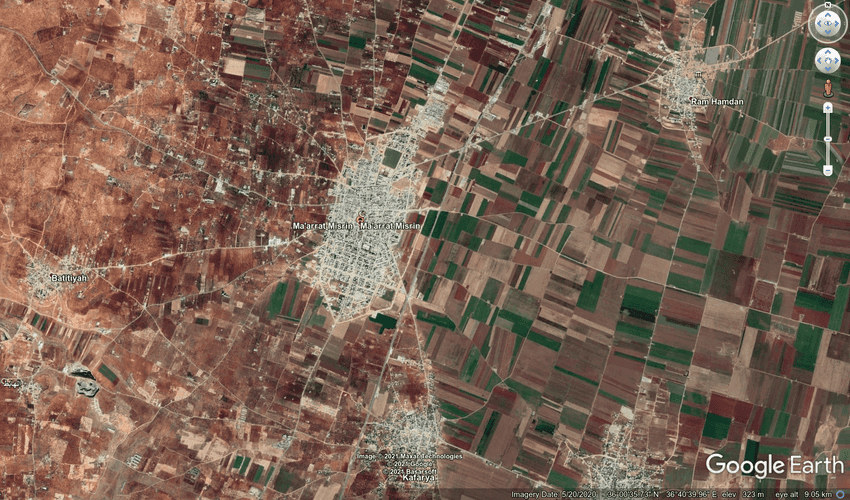 Satellite imagery from Google Earth of Maaret Masreen.
Satellite imagery from Google Earth of Maaret Masreen.
Idlib, Maaret Masreen, and Al Dana became a refuge for hundreds of thousands of displaced peoples fleeing areas with intense clashes and airstrikes. A large number of civilians fled specifically during the recent 11 month long military operation in Idlib and the countrysides of Aleppo and Hama launched by the Syrian government with the support of Russia and Iran. This operation killed thousands of civilians and displaced about 800,000 people between December 2019 to February 13, 2020, according to the United Nations Office for Humanitarian Affairs (OCHA). The UN Office reported that 550,000 of those displaced (81% of whom were women and children) went to the cities of Idlib, Maaret Masreen, and Al Dana.
According to 2019-2020 data from the Syrian Response Coordination Group, the total number of displaced people in the Idlib governorate reached about two million with a population density of about 998 people per square kilometer. About a million IDPs live in the 1,277 designated camp in the area, while 180,000 IDPs live in 366 informal camps. The rest of those displaced in the area live in tents nearby roads, schools, abandoned shelters, caves, under olive trees, or in rented houses.
Mustafa Haddad, head of Maaret Masreen’s local council, told Syrian Archive that the population of the town had doubled before the two attacks. According to Haddad, the population of Maaret Masreen reached about 105,000 people of which 51,000 were IDPs. However, the latest attacks on Maaret Masreen caused residents to flee to safer areas. Haddad added that those killed in the two incidents were displaced people—mostly women and children—who came to Maaret Masreen seeking safety. He also emphasized that the poultry farm and school hit in the attacks did not house any soldiers and that there are no military headquarters near them in the area.
The First Attack: Mounib Kamisha School
What Happened (and When)?
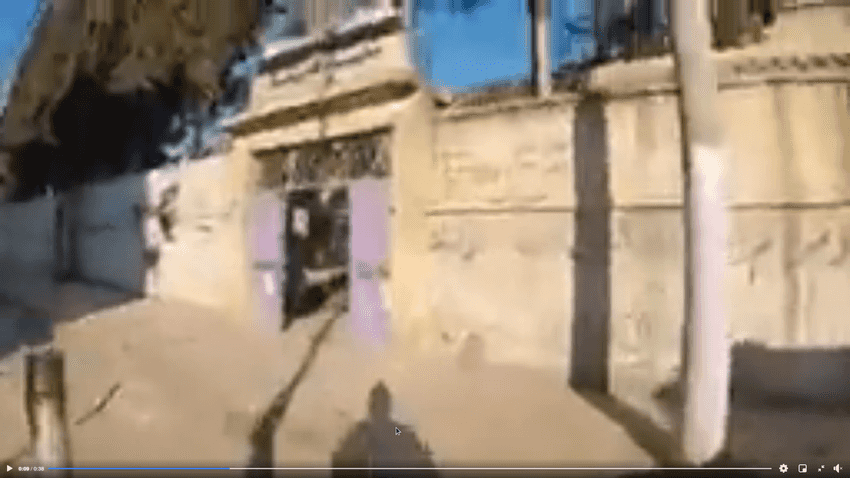 Mounib Kamisha School after the attack as shown in a video posted by media activist Hadi Al Abdullah.
Mounib Kamisha School after the attack as shown in a video posted by media activist Hadi Al Abdullah.
Between 15:30 - 16:00 on February 25, 2020, 3 thermobaric (vacuum) missiles hit a city block with the Mounib Kamisha and Zuhair Radwan schools in Maaret Masrin, according to sources posted online as well as interviews conducted by Syrian Archive with witnesses and school staff.
Reports of the incident began circulating on social media just before 16:00. The Maaret Masrin Coordination Facebook page posted news of an attack on the town with two missiles from an airstrike. Journalist Milad Fadal also posted pictures on his Facebook page of smoke over Maaret Masrin from the airstrikes on the town. Half an hour after his initial post, Fadal also posted a picture showing a crater near the Kamisha school caused by one of missiles.
A picture posted by journalist Milad Fadal showing smoke over Maaret Masreen from the airstrikes on the town.
An identification of mosques featured in media showing the attack.
The minaret in the background of the first photo posted by Milad Fadal matches the minaret of Al Farouqi Mosque in Maaret Masreen. The Al Farouqi Mosque is less than a kilometer east of the alleged impact site. The minaret shown in the second photo posted, 30 minute later, by Milad Fadal shows the minaret of the Al Hassanin Mosque, which is less than 250 meters away from the impact site. Using landmarks such as the minarets, Syrian Archive was able to determine where the photos were taken from, verifying that the smoke shown in the photos were from airstrikes on the Mounib Kamisha School.
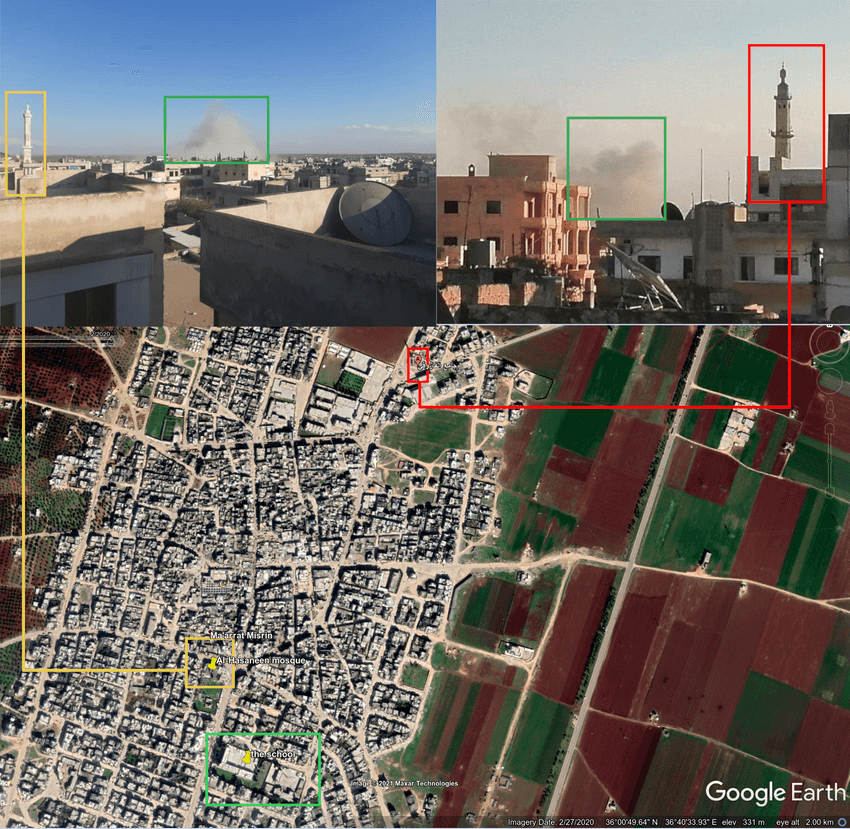 A geolocation of where the photos published by Milad Fadal were taken from. The smoke shown in the photos were from the airstrikes on the Mounib Kamisha School.
A geolocation of where the photos published by Milad Fadal were taken from. The smoke shown in the photos were from the airstrikes on the Mounib Kamisha School.
About fifty minutes after the incident, Maaret Masreen Coordination Facebook page posted alerting of people killed and injured by airstrikes on the town. Facebook user Hamza Al Khatib also posted a video showing the moments after the attack, noted by the amount of smoke and dust in the air, when Civil Defense teams arrived at the impact site. A sign at the beginning of the video includes the name of the school hit in the attack. The video also shows civilians attempting to rescue victims under the rubble. A video from the Zeitoun News Agency shows the moments directly following the attack as women and children flee to safer places, grabbing their belongings and leaving the area.
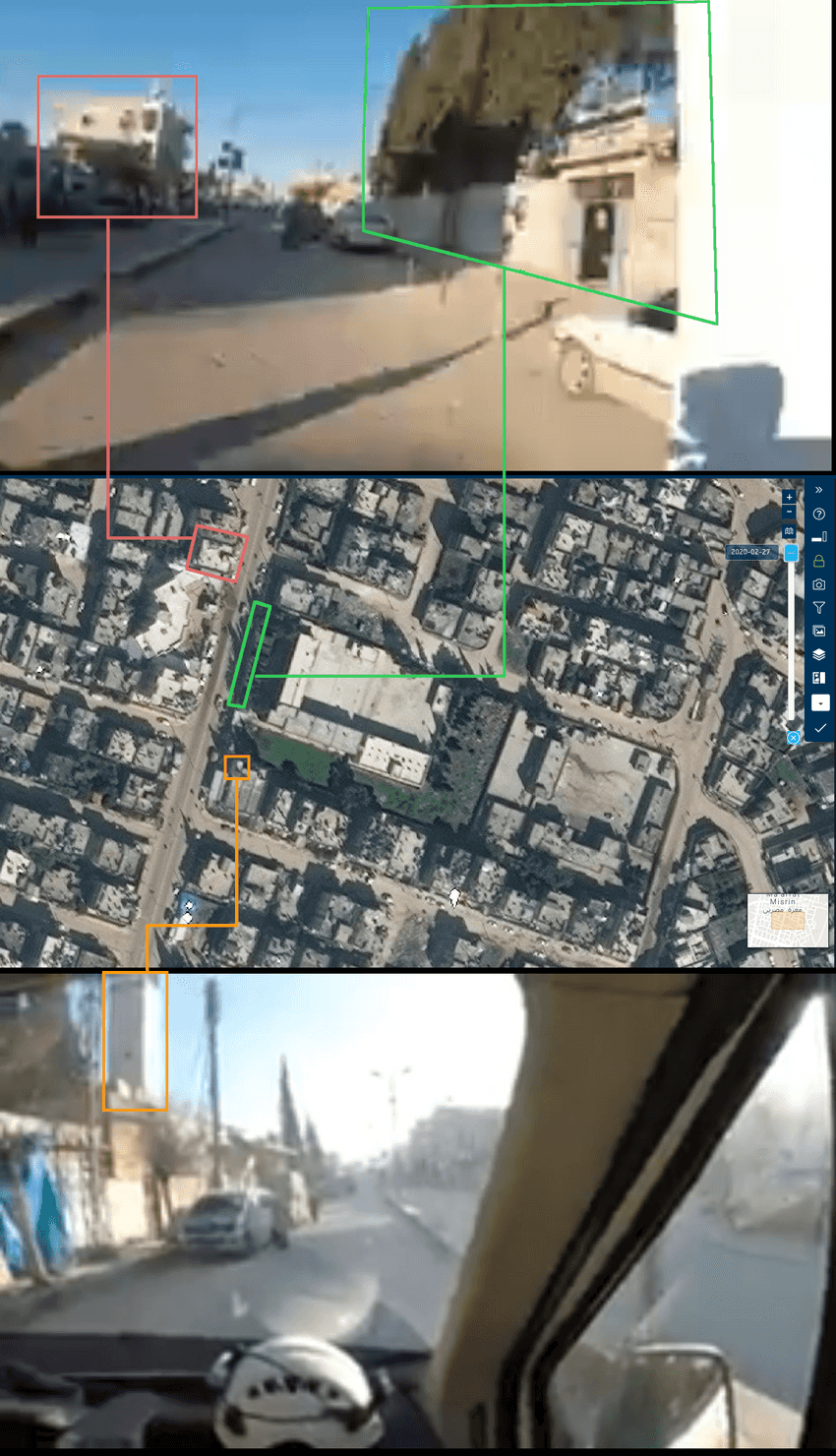 Landmarks shown in a video posted by Facebook user Hamza Al Khatib match what’s shown on satellite imagery of the Mounib Kamisha School.
Landmarks shown in a video posted by Facebook user Hamza Al Khatib match what’s shown on satellite imagery of the Mounib Kamisha School.
Two hours after the attack, Syria TV and media activists Hadi Al Abdullah posted videos showing the damage to the Mounib Kamisha School and surrounding areas after the attack.
A video posted by Baladi News Networks shows the moment paramedics arrived at the impact site. The report shows a civilian killed in the attack and the efforts by first responders to rescue the injured. Tamer Turkmani, in a video posted on his YouTube channel, shows the search and rescue efforts including a wounded woman near the school who was pulled out from under rubble.
Additionally, Smart News Agency, Enab Baladi, Al Jazeera Mubashir, and the journalists Bilal Al Ghawi and Khatib Al Idlibi posted videos showing the locations where the two missiles hit as well as the craters caused by their fall.
In an interview with Syrian Archive, the president of Maaret Masreen’s local council, Mustafa Haddad, said that most of the residents in the areas hit in the attack were displaced. Haddad’s statement is corroborated by the names of victims and testimonies of witnesses who stated were from areas in the southern countryside of Idlib and moved north once Syrian government forces took control. The Violations Documentation Center in Syria (VDC) counted 1,092 attacks alone in the Idlib governorate in the month of February 2020. 116 civilians were killed in these attacks, including 39 children, 2 media activists, 3 medical workers, and two teachers. The attacks, according to the VDC, were focused on civilian infrastructure as they hit 17 schools, a kindergarten, 6 hospitals, 3 camps for the displaced, and a bakery.
In a report on the attack, the Syrian Network for Human Rights stated that a fixed wing aircraft hit a gathering of shelters for displaced persons in Maaret Masreen, killing civilians and damaging residential buildings/structures.
A report by VICE News on the attack stated that the strike took place around 15:37 local time. Utilizing shadows shown in a variety of open source materials documenting the direct aftermath of the attack, Syrian Archive was able to confirm that the timing of the incident occurred between 15:30 - 16:00. Shadows shown in a video posted by Hamza Al Khatib of the moments directly after the attack matches the sun’s position (calculated using SunCalc) between 15:00 - 16:00 on February 25, 2020.
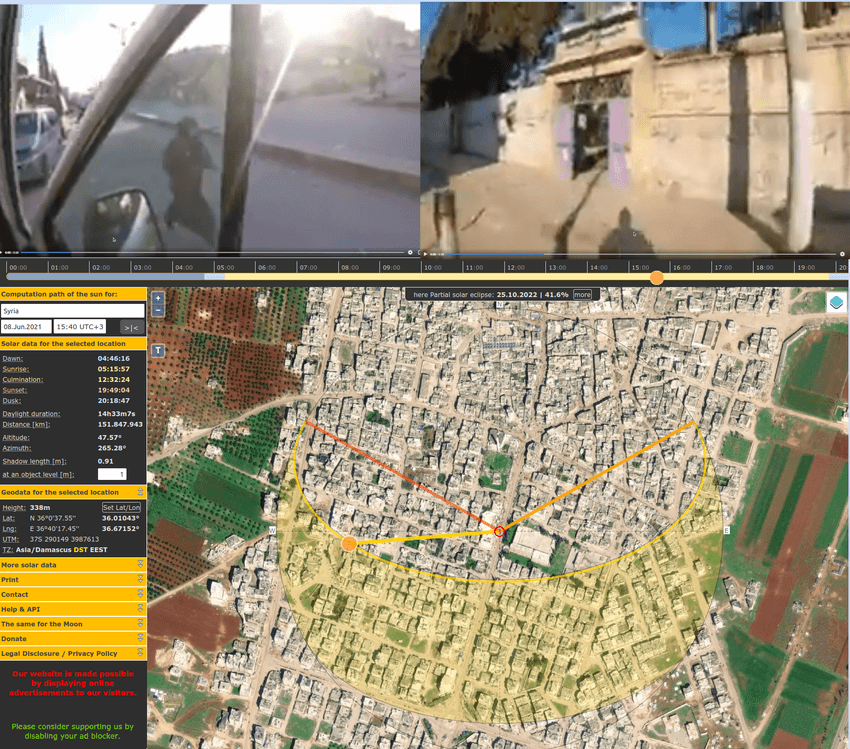 Shadows shown in a video posted by Hamza Al Khatib on Facebook, showing the direct aftermath of the strike, correspond to the location of the sun between 15:00 - 16:00 in Maaret Masreen on February 25, 2020 as calculated using the SunCalc tool. This corroborates the timings mentioned by witnesses and in online reports.
Shadows shown in a video posted by Hamza Al Khatib on Facebook, showing the direct aftermath of the strike, correspond to the location of the sun between 15:00 - 16:00 in Maaret Masreen on February 25, 2020 as calculated using the SunCalc tool. This corroborates the timings mentioned by witnesses and in online reports.
Witness Testimony
In a video report by VICE News about the attack on the Kamisha School, nine year old Dala described what happened the day of the attack. She said she heard the sound of the plane and then saw people and children injured by the missile, which hit the center of the school. In the video, Dala struggles with walking because of her injury from the attack. She also is scared of the sound of planes. The report shows her trembling while telling the reporter what she witnessed when the airstrike hit the school.
In a video report on the attack by Baladi News, the director of the Civil Defense in Maaret Masreen said that the airstrikes hit densely populated residential neighborhoods. The report shows the damaged buildings near the school and provides an initial report of 5 civilians killed and 30 injured in the attack, most of those killed and injured were displaced.
The Damage to the School and the Surrounding Areas
Satellite imagery from Digital Globe of the school before and after the attack.
The locations the missiles hit as shown in videos posted by Baladi News Agency and Zeitoun News Agency.
Videos collected and verified by Syrian Archive, including from SMART News, Enab Baladi, Al Jazeera Mubashir, Zeitoun News, and journalists Bilal Al Ghawi and Khatib Al Idlibi, show where the missiles hit and their craters. The videos also show the school wall which was damaged in the attack as well as shrapnel in trees from the missiles. The videos also show downed electricity poles, splatters of blood, as well as collapsed balconies and columns in the buildings surrounding school. Additionally, the footage shows damage to the school’s bathrooms, furniture, doors, and windows. Buildings and vehicles within a 200 meter diameter of the school in all directions were severely damaged by the strikes.
Pictures from video reports by SMART News, Enab Baladi, Al Jazeera Mubashir, Zeitoun News, and journalists Bilal Al Ghawi and Khatib Al Idlibi show the severe damage to the school and the surrounding areas after the attack.
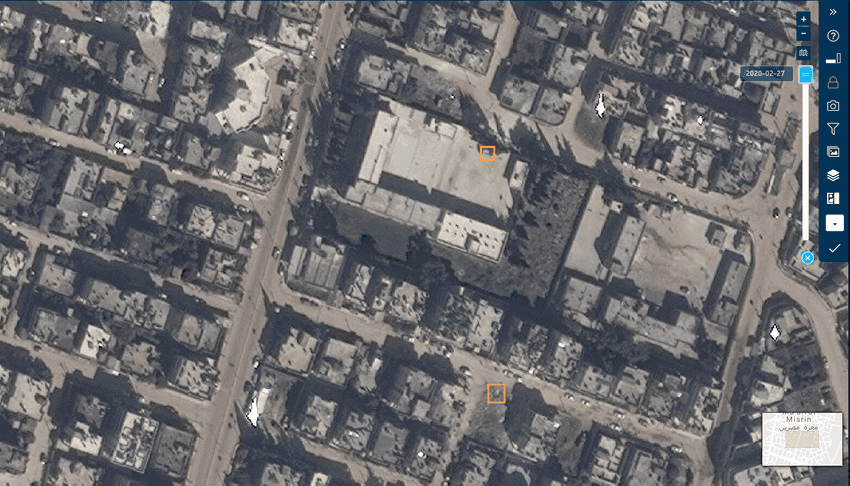 The location of craters from the strikes as shown in satellite imagery.
The location of craters from the strikes as shown in satellite imagery.
### Killed and Injured
The football team Ashbal Maaret Masreen misses its player Abdel Rhaman Sameh Armanazi who was killed in the airstrikes on the school.
Ten people in total were killed in the strikes, including:
- Mohammed Samir Kashour
- Leith Mazin Aqdah Armanazi
- Abdel Rahman Armanazi
- Abdo Armanazi
- Ahmed Al Hamoud
- Amal Mohammed Abboud
- Abdel Rahman Sariya
- Abdullah Yasser Al Zalam
- Mohammed Hussein Al Helou
- Unidentified man
Flight Data Analysis
To obtain flight observation data, Syrian Archive monitored local observatory channels on Telegram. These channels publish warnings of when planes that may potentially attack a location are approaching. Among these channels is the Syria Observatory channel, which posted at 15:52 alerting of a Su-24 flying west over Maaret Masreen and 4 minutes later at 15:56, an alert of a Su-24 circling above the town.
The common practice of circling by warzone aircrafts generally indicates a target acquisition and/or preparation for an imminent strike. The circling by Su-24 aircraft, commonly used by Syrian government and Russian Forces, over Maaret Masreen further corroborates the estimated time of the attack.
Although, this data further confirms the time the incident occurred, there is no information available indicating that one of the observed aircraft was directly involved in the strike detailed above. Nevertheless, the presence of Su-24 warplanes above Maaret Masreen around the time of the strikes further confirms the purported times the missile hit the Kamisha school.
Summary
At around 15:40 on February 25, 2020, airstrikes hit the Mounib Kamisha School in Maaret Masreen killing 10 civilians and wounding 30 others, including women and children, as well as severely damaging the school and the surrounding areas.
The Second Attack: A Poultry Farm in Maaret Masreen
What Happened (and When)?
A video posted by the Syrian Civil Defense of the damage to the poultry farm from the attack.
The bombing of Maaret Masreen continued until the announcement of the Russian-Turkish ceasefire agreement. Ten days after the Mounib Kamish School was hit by airstrikes, in the early hours of Thursday, March 5, 2020, two poultry farms and the surrounding area were hit by airstrikes. The area hit was residential with around 100 displaced persons, some of those hit in the attack were farm workers. The strikes killed 16 people and wounded about 20 others.
At 04:26, the morning of March 5, 2020, the Facebook page Maaret Masreen news posted a news alert of Russian planes hitting the town with successive air raids of high-explosive missiles at 02:00. At 06:53, the page reported 4 people killed with ongoing Civil Defense team operations to rescue those injured in the attack. At 09:23, the page reported 16 dead and around 35 people wounded by the strikes.
A number of local news organizations reported on the attack showing the damage to the surrounding areas, including Syria TV, the Syrian Civil Defense, the Syrian Civil Defense - Central Directorate, Orient News, Mov News, Shaam News Network, Macro Media Center, SY+, Zeitoun News, and Al Arabi TV.
Additionally, the accounts Ahmed Rahal, Anas Tracey, Mohammed Belaas, Ahmed Abu Muawiyah, Iyad Abu Al Joud, and Ibrahim Yassouf posted videos showing the extent of damage to the farmhouse area. Some videos included interviews with first responders and residents of the area.
The Facebook page Maaret Masreen News also published several videos showing the damage from the attack as well as those killed by the strikes.
Videos posted by the Facebook page Maaret Masreen News, the Syrian Civil Defense, Syria TV, and Al Jazeera show the moments immediately following the attack as Civil Defense teams worked to recover and rescue the killed and injured from under the rubble. Operations continued well into the morning as documented in a video posted by the Syrian Civil Defense.
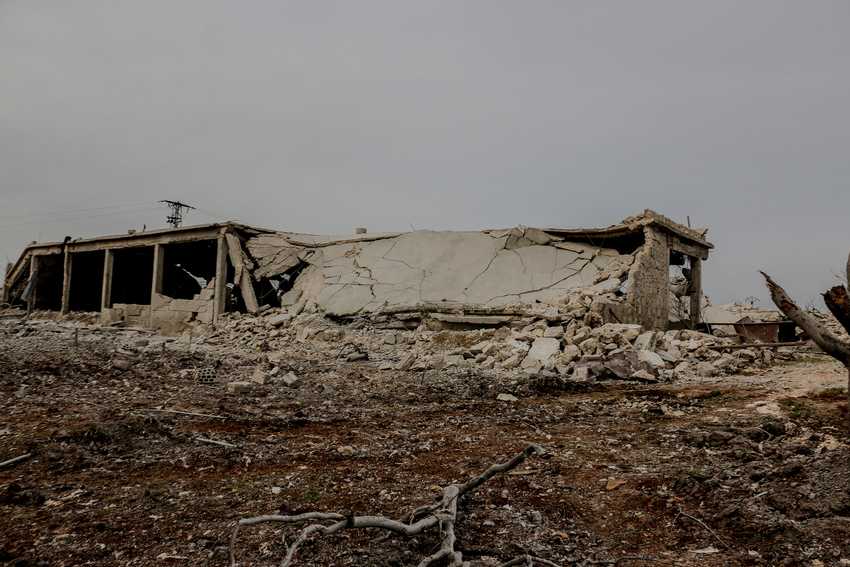 A picture posted by the Facebook account Ahmed Akacha showing the farmhouse after the attack.
A picture posted by the Facebook account Ahmed Akacha showing the farmhouse after the attack.
Additionally, the Facebook page for the Syrian American Medical Society (SAMS) posted of airstrikes on Maaret Masreen after midnight on March 5, 2020. SAMS reported that the Maaret Masreen Hospital, a facility the organization supports, recorded 16 dead and 28 injured from the attack. The Syrian Network for Human Rights also published news of a bombing of a village for the displaced in the western outskirts of Maaret Masreen by a fixed-wing aircraft that they believed belonged to Russian forces.
Pictures posted by the SAMS Facebook page showing the operations to rescue those injured in the attack.
Testimonies from first responders
In an interview with the Syrian Archive team, Hatem Abu Marwan, director of the Civil Defense Center in Maaret Masreen (western Idlib sector) said that at exactly 2:01 AM on Thursday, March 5, 2020, Russian warplanes attacked the outskirts of Maaret Masreen with three vacuum missiles. Abu Marwan told the investigations team that the town had suffered from a bloody week before the targeting as a number of intense attacks hit Maaret Masreen and the surrounding areas. Abu Marwan was sleeping at home when the sound of a strong explosion nearby woke him up. Confirming the time of the strike, Abu Marwan spoke of communicating with the team in the operations center who went directly to the site of the attack.
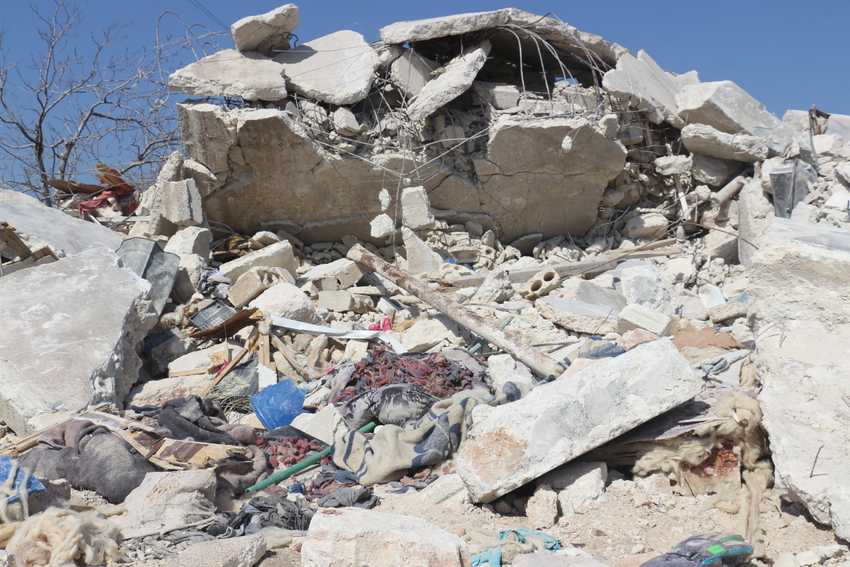 A photo taken by Syrian Archive’s investigations team.
A photo taken by Syrian Archive’s investigations team.
Abu Marawn told the investigations team: “I was following them [the team] using the walkie-talkie. The team leader at the site was running the rescue operation. He told me about the victims, including children. During the rescue operation, a reconnaissance plane was hovering in the same place. The observatories transmitted its movement. According to my experience, any place where reconnaissance planes are located will be targeted. This has happened multiple times before and the victims of these attacks are often volunteers and civilians, resulting in many injuries. This is a tactic that they deliberately follow, targeting medics and volunteers after they’ve gathered in areas searching for survivors.”
Abu Marwan added, “After the first batch of injured civilians were removed, I asked the team and civilians to evacuate because of the reconnaissance plane, but they were unlucky. The team leader told me that he was injured after a second raid was carried out by the plane.”
Abu Marwan told us he reached the impact site, taking command of the rescue team, after he requested assistance from Civil Defense Centers in the surrounding areas. He says that both attacks on Maaret Masreen were with vacuum (also known as thermobaric) missiles, and that the second attack targeted the team hitting near their rescue operations.
The director of the center continued, “The screaming of women and children was the first thing I heard when I arrived, people moaning from under the rubble, we could hear them and tried to reach them. The attack hit three points, which forced us to prioritize first aid according to the most severe cases. Reconnaissance planes did not leave the area, forcing us to move the ambulances to away from the impact sites. We hid them underneath trees and carried the injured on stretchers, walking them to the ambulances in fear of being targeted.”
The rescue operations at the impact site lasted around seven hours. The team recovered around 16 killed, including three children and a baby, and about 20 wounded. According to Abu Marwan, it was a “massacre in the truest sense of the word.” Abu Marwan described the victims as mostly displaced people fleeing the bombing only to find it right where they’ve recently resettled. “There are no military headquarters or frontlines near the impact sites. It is a poultry farm, where some residents work and live. Near the poultry house there are beehives (for beekeeping), and now damaged residential homes. After we completed transporting the injured, machinery entered the impact site to remove the rubble from the area.”
In an interview with Syrian Archive team, Mohammed Aden, the Civil Defense team leader on duty at the time of the attack, corroborated Abu Marwan’s statements and online reports on the incident. Aden told the team, “At exactly 2:02, Russian warplanes carried out an air raid on the outskirts of Maaret Masreen. Three volunteers left in an ambulance to the location of the attack, to see if it was a major one, and if we needed to ask for support through the radio.”
Aden added, “When we arrived at the impact site, we assessed the general situation, informing the center that we needed support. We started carrying those present with injuries that did not need to be searched for. They were five people with mild injuries who were transferred. The center told us there was a reconnaissance plane flying over the place and panic ensued. Through some of the residents we were able to determine that there were three areas where people were trapped under the rubble. I asked the director of the center for a team from the Idlib governorate center because we needed special equipment to recover the victims.”
Aden added that while sending the first batch of those injured to the hospital, warplanes returned above the town, and “fired a missile at the location where the ambulance had left a short time ago. It was about twenty meters away from me. I knew that the reconnaissance plane had given the ambulance’s coordinates to the warplane that carried out the attack. I was hit by small shrapnel and the loud sound made me lose my balance. The support team arrived and I was taken to the center after the director took over leadership of the team when he arrived.” Aden said the time of the second attack occurred at 2:13 AM and confirmed that the first attack was with three missiles.
The investigations team also interviewed Abu Wael, a nurse from Maaret Masreen Hospital. The nurse said, ��“I went to the hospital at dawn on Thursday after a huge explosion woke me up. It was 2:27 AM when I arrived at the hospital and when injuries began to arrive as well.” Abu Wael said that the hospital counted 15 people killed, which included 3 children and 7 women. The hospital also received 20 injured, among them 4 women and 2 children. Abu Wael said, “We received the injured and transferred some cases to close-by hospitals and speciality hospitals. The number of those killed before they reached the hospital was large and many still remained under the rubble.”
The Damage from the Attack
Satellite imagery from Digital Globe of the school before and after the attack.
Taking photos and videos, the Syrian Archive investigations team documented the damage caused by the two airstrikes on the outskirts of western Maaret Masreen. The team compared photos and videos they had taken with the information posted online about the attack and its aftermath.
The airstrikes destroyed around ten homes and two poultry farms. The farms contained around 17,000 birds, most of which died during the attack. The poultry farm was also a home for around ten families, about 50 people.
Videos taken by the investigations team show one of the two poultry farms completely destroyed. The farm’s roof collapsed, now rubble after the attack. Near the collapsed farmhouse was a home belonging to a family displaced from Bab Al Taqa near the Hama countryside. The home was partially destroyed by the attack with damage to some of the house’s walls, furniture, and bathroom. The home is covered in rubble. Nearby this home is the second poultry farm, which suffered from significant damage to its roof. Within the farm houses are a large number of dead chickens, surrounded by rubble from water and feed tanks destroyed by the blasts.
The attack also resulted in the destruction of 5 houses around the poultry farms and completely destroyed a house around 100 meters away from the farms. Videos taken by the investigations team show the craters where the missiles hit Maaret Masreen as well as the trees, windows, and doors destroyed by missile’s shrapnel.
The attack also severely damaged a car filled with furniture and parked near a house by the farms. The walls of the house by the car were cracked by the blasts.
Photos and videos taken by the investigations team corroborate information posted online regarding the severe damage to the poultry farms and the surrounding homes from the airstrikes.
Pictures taken by Syrian Archive’s investigations team of the damage to the poultry farms and the surrounding homes from after the attack.
Killed and Injured
16 people were killed in the attack, 15 of those were identified and documented, and about 21 of those injured were identified and documented. Photos and videos posted online show some of those killed in the attack with posts mourning the deaths of six members of a family originally from Bab Al Taqa in the Hama countryside. A video posted on Facebook also mourned the death of members of the Harkoush family, originally from the city of Al Safira in the Aleppo countryside, who were also killed in the attack.
The names of those killed by the airstrikes on March 5, 2020
- Amira Mohammed Hussein Al Saleh Al Harkoush from Al Safira in the Aleppo countryside
- Mohammed Hussein Al Saleh Al Harkoush from Al Safira in the Aleppo countryside
- Mohammed Al Saleh Al Harkoush from Al Safira in the Aleppo countryside
- Zeinab Al Harkoush from Al Safira in the Aleppo countryside
- Fatima Al Harkoush from Al Safira in the Aleppo countryside
- Ibrahim Mohammed Al Hussein Al Saleh Al Harkoush from Al Safira in the Aleppo countryside
- Ahmed Al Saleh from Al Safira in the Aleppo countryside
- Ahmed Al Ghadban from Bab Al Taqa in the Hama countryside
- Aya Salim Qutaish from Bab Al Taqa in the Hama countryside
- Maya Salem Qutaish from Bab Al Taqa in the Hama countryside
- Elaine Mohammed Qutaish from Bab Al Taqa in the Hama countryside
- Jamila Ibrahim Al Saleh from Bab Al Taqa in the Hama countryside
- Yaza Hammond from Bab Al Taqa in the Hama countryside
- Mohammed Mustafa Eid from Al Mastouma in the Idlib countryside
- Yasser Hammoud
- Unidentified woman
The names of those injured in the airstrikes on March 5, 2020
- Khalil Mohammed Harkoush
- Mira Harkoush
- Abdo Al Sheikh
- Maryam Bazaa
- Rashida Bazaa
- Mohammed Al Sheikh
- Qasim Al Sheikh
- Baraa Al Sheikh
- Abdullah Al Sheikh
- Ahmed Salem Qutaish
- Mohammed Ahmed Qutaish
- Salem Ahmed Qutaish
- Ahmed Qutaish
- Salha Youssef Al Saleh
- Ahmed Al Saleh
- Ibrahim Al Saleh
- Youssef Ali Deib
- Omar Youssef Deib
- Ali Youssef Deib
- Ismail Azazi
- Khitam Adel Khalawi
Flight Data Analysis
To obtain flight observation data, Syrian Archive monitored local observatory channels on Telegram. These channels publish warnings of when planes that may potentially attack a location are approaching. Among these channels is the Syria Observatory channel. On March 5, 2020, at 01:47, the Syria Observatory channel posted of a Russian warplane flying south over Idlib (~10 km south of Maaret Masreen). At 01:59, another alert appeared of a Russian warplane flying in a circle over Jabal Al Zawiya (~30 km south of Maaret Masreen). At 02:01, an alert was sent of a warplane circling over Maaret Masreen. At 02:04, the channel published an alert of a reconnaissance plane circling over Maaret Masreen. Lastly, at 02:06 and 02:13 additional alerts were posted of a Russian warplane circling over the town.
The common practice of circling by warzone aircrafts featured in this data set generally indicates a target acquisition and/or preparation for an imminent strike. The circling by Russian warplanes over and near Maaret Masreen corroborates the estimated time of the incident as reported by the Syrian Civil Defense, open source media, and witnesses interviewed by the investigations team.
Although, this data further confirms the time the incident occurred, there is no information available indicating that one of the observed aircraft was directly involved in the strike detailed above. Nevertheless, the presence of Russian warplanes above Maaret Masreen and neighboring towns at or around the time of the strike further confirms the purported times the airstrikes hit the poultry farms and surrounding civilian homes on the outskirts of Maaret Masreen.
Summary
At around 02:00, the morning of March 5, 2020, two airstrikes hit poultry farms sheltering displaced civilians west of Maaret Masreen. The attack killed 16 civilians, wounding 21 others, and caused extensive damage to the poultry farms and surrounding civilian homes.
Conclusion
Through the information detailed above, Syrian Archive confirmed that an airstrike hit the Mounib Kamisha school in Maaret Masreen on February 25, 2020 at around 15:40. On March 5, 2020, at 02:00 AM airstrikes also hit poultry farms and surrounding civilian homes in west Maaret Masreen. The first attack killed 10 civilians and injured 30 others, including women and children, as well as severely damaged the school and its surrounding area. The second attack, which occurred 10 days later, killed 16 civilians and injured 21 others, damaging the poultry farms and surrounding residential homes. Given the limitations of open source investigations, Syrian Archive is unable to definitively identify those responsible for the strike. However, open source information as well as testimonies taken by the investigations team point to the Russian or Syrian government forces as likely responsible for both incidents.
